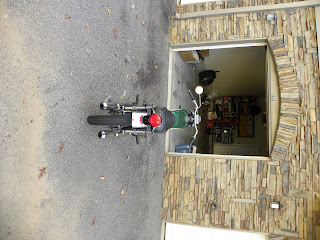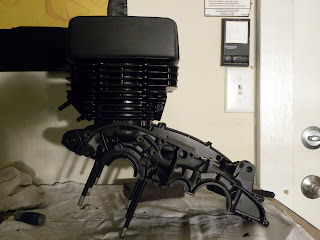1972 Yamaha DS7
Monday, March 19, 2012
Wednesday, March 7, 2012
Cleaning Nuts and Bolts
So buying new hardware is pretty expensive I have found out so I am going to refinish the original hardware. I have come up with a couple of methods but I am not sure which work best. So I will let you know how it goes. Probably will be a combination of the tumbler, and evapo-rust.
1. Vibratory Tumble with rust cutting media
2. Wire wheel
3. Evapo-rust
4. Degreaser Solution
5. Coke-a-Cola
1. Vibratory Tumble with rust cutting media
2. Wire wheel
3. Evapo-rust
4. Degreaser Solution
5. Coke-a-Cola
Friday, March 2, 2012
DS7 Update
I just picked up a used R5 engine which is basically the same as the DS7 with exception to a larger displacement. I bought it to help me put the DS7 engine back together and will also probably rebuild it at some point. I will post some more when I start rebuilding the engine.
Monday, December 5, 2011
Tuesday, September 6, 2011
Saturday, September 3, 2011
First part installed!
These are the first parts I installed since I tore it apart. I had to find a picture to remember how the foot peg bracket faced, oh the fun ensues. I tightened each nut by hand and then a cross pattern to make sure the bushing were seated properly.
Powder coated foot peg bracket and mounting hardware accompanied by fresh bushing inserts, courtesy of HVC Cycle.
Powder coated foot peg bracket and mounting hardware accompanied by fresh bushing inserts, courtesy of HVC Cycle.
Tuesday, August 30, 2011
Monday, August 29, 2011
DS7 Update
This is a NOS item, somethings are okay to get NOS but the float bowl gasket was basically worthless, it was some paper based compound that was extremely brittle, and broke.
Tire, tube, wheel-removing the tire was quite a challenge, I had the tools, a step by step and even a video and still had trouble, but I got it!
Tire irons, and wheel savers. These tools are manditory for tire removal.
Tire, tube, wheel-removing the tire was quite a challenge, I had the tools, a step by step and even a video and still had trouble, but I got it!
Tire irons, and wheel savers. These tools are manditory for tire removal.
Sunday, August 28, 2011
A little mystery solved...
So I have been working on this bike for roughly a year. I have a vast knowledge in automobiles but this two-stroke engine really baffled when I didn't know what kind of oil, or different types of oil this bike took. I was thinking two stroke oil for burning, engine oil for lubricating, and transmission oil. As I thought about it there was no way this bike could have three separate types of oil, I was right. So I did some extensive research. In a traditional automobile you have oil that the lubricates the internal dynamic parts in the engine. The oil is stored and sits at the bottom of the engine in a oil pan aka sump, this is a wet-sump application. The 1972 DS7 has oil injection from an external reservoir that is pumped into the head where is mixed with air and fuel in the crank case and then combusted in the combustion chamber, before the ignition occurs the complete mixture travels throughout the crankcase first lubricating the bearings, crankshaft, rods, and pistons, this is a dry-sump application. Here is the description that helped explain it a little more:
Two-cycle motors are considered total-loss type lubricating systems. Because the crankcase is part of the intake process, it cannot act as an oil sump as is found on four-cycle engines. Lubricating traditional two-cycle engines is done by mixing the oil with the fuel. The oil is burned upon combustion of the air/fuel mixture. Direct Injection engines are different because the fuel is directly injected into the combustion chamber while the oil is injected directly into the crankcase. This process is efficient because the fuel is injected after the exhaust port closes, and therefore more complete combustion of fuel occurs and more power is developed.
Two-cycle motors are considered total-loss type lubricating systems. Because the crankcase is part of the intake process, it cannot act as an oil sump as is found on four-cycle engines. Lubricating traditional two-cycle engines is done by mixing the oil with the fuel. The oil is burned upon combustion of the air/fuel mixture. Direct Injection engines are different because the fuel is directly injected into the combustion chamber while the oil is injected directly into the crankcase. This process is efficient because the fuel is injected after the exhaust port closes, and therefore more complete combustion of fuel occurs and more power is developed.
Subscribe to:
Comments (Atom)





























































